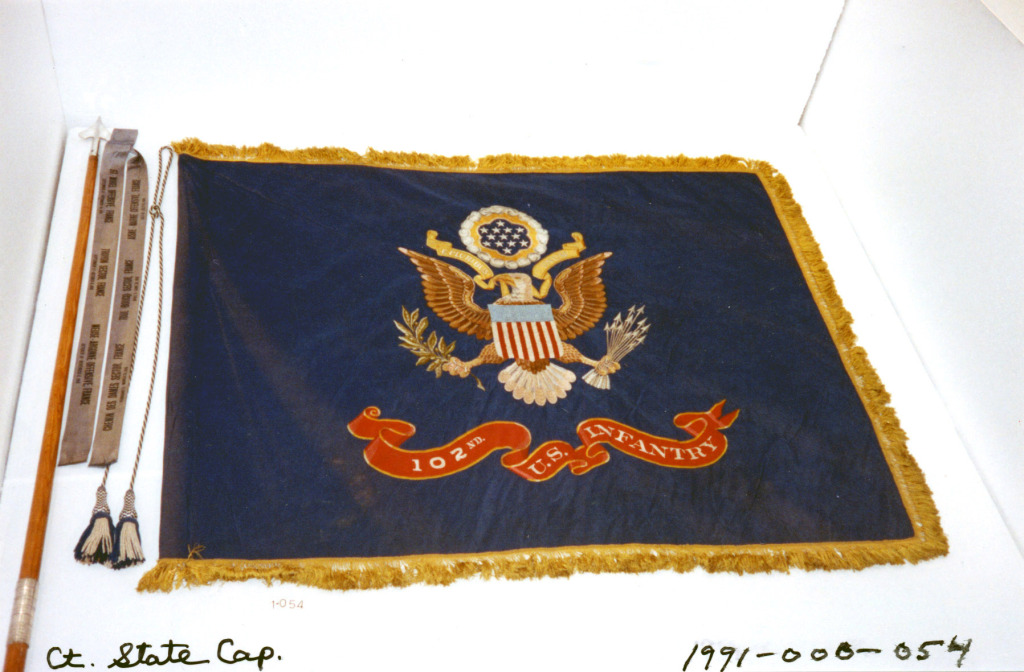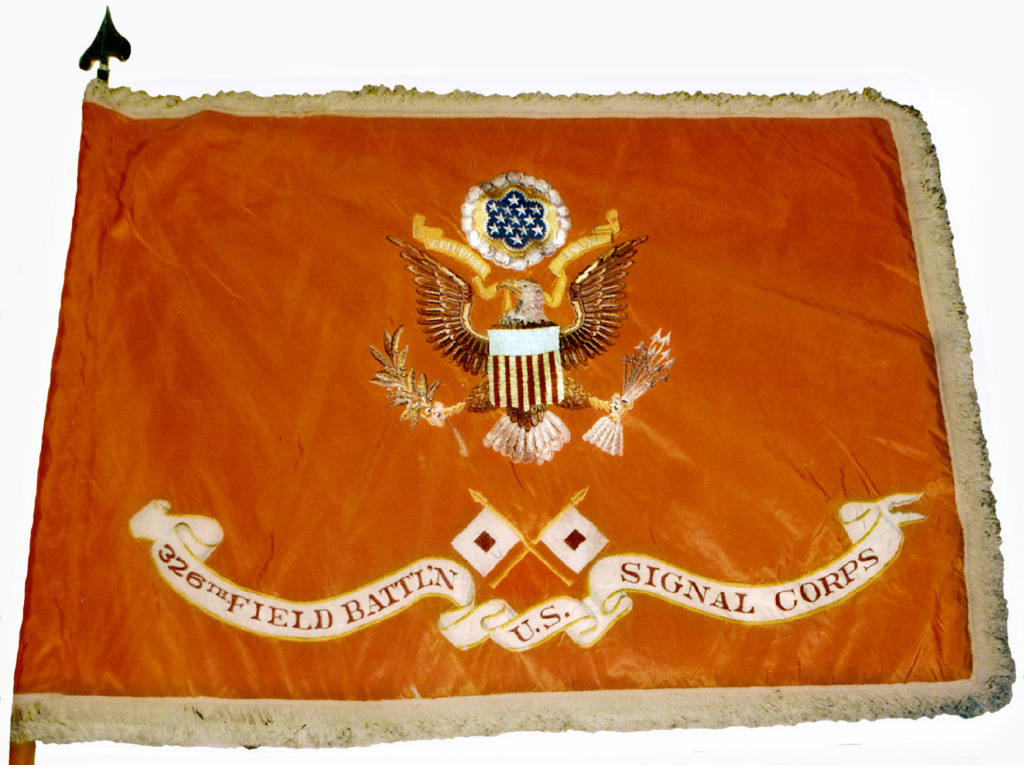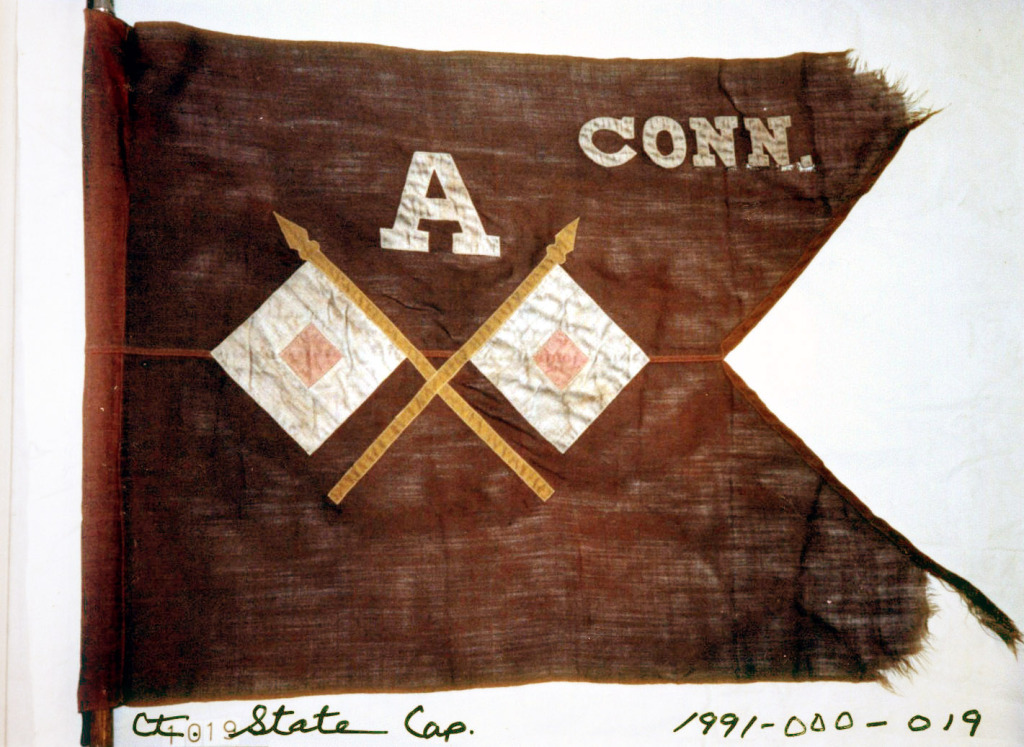Today’s Friday Find comes to us from Bill and Geraldine S. Caughman. Gerry Caughman was the author of an amazing two volume set of books called Qui transtulit sustinet : Connecticut Battle Flag Collection. This set documents the history of the Connecticut Capitol collection of battle flags. Volume one documents the flags of the Civil War while the second volume focuses on battle flags from the Spanish American War and beyond. A great portion of this second volume covers World War one and the colors flown during the war. Below are just a few of the flags from that volume.
In early 1917, Governor Marcus Holcomb started preparing Connecticut for war by mobilizing the Connecticut National Guard to protect the citizens and industry from sabotage. The 1st Regiment out of Hartford and the 2nd Regiment out of New Haven were among the oldest regiments to be mobilized, each tracing their roots to colonial times, and naturally there was some healthy rivalry. In August of 1917 both troops were federalized but neither regiment satisfied the Regular Army regulations on regiment size. The War Department solved this by creating the 102nd U.S. Infantry with men from the 1st and 2nd Regiments. The troops, who were unhappy with this arrangement, eventually resigned themselves to it and dubbed themselves “One and Two with Nothing in Between”.
For the first time in its long history, Connecticut men carried to the battlefield what could be termed a generic regimental flag. The central device con sited of a beautifully embroidered Coat of Arms of the United States. It was made of blue silk which is the traditional color for the Infantry. The ash staff (pike) was nine feet long and the finial (spearhead) was nickel plated. The size of this flag is 52″ x 61″ and there is a Quartermaster label in the sleeve. [p.42]
The newly formed 102nd U.S. Infantry Regiment became part of the 26th Division also known as the Yankee Division due to its makeup of New England troops. Also federalized was a signal unit from the Connecticut National Guard.
On January 16th, 1918 22 Connecticut men were assigned to Company C of the newly constituted 326th U.S. Field Signal Battalion, and the remainder became the nucleus of Company A, 326th Signal Battalion. (Note: Company B of the 326th was from New Hampshire.)
The 326th Signal Battalion, under the command of Captain Curtis L. Sheldon, was sent to France from August 14, 1918 to June 27, 1919. On their return, to the United States, final reports were made at Camp Upton, New York and on July 3, 1919, the 326th Signal Battalion ceased to exist.[p. 65]
The organizational standard is pictured above and its size was “four feet fly and three feet on the lance.” The guidon below was identified as belonging to the 326th by labels attached to the staffs, which also affirm that these flags were carried during WWI.
If you’ve never visited the Connecticut State Capitol and the Hall of Flags, I would encourage you to do so. It is a stunning building and a National Historic Landmark.
Gerry Caughman, was a member of the League of Women Voters and a tour guide at the Connecticut State Capitol in Hartford for over 30 years. She began taking care of the Capitol’s 170-piece battle-flag collection in 1985, and in 1989 she became a member of the Capitol Battle Flag Commission. Gerry and Fran Moir, another member of the commission, began a survey of the flags that included cataloging, marking and photographing the entire collection of 110 battle flags and persevered to make sure these historic flags were preserved. We’d like to remember and honor Geraldine S. Caughman for her hard work in documenting and preserving these amazing flags. We’d also like to extend our thanks to her husband Bill for calling our attention to them and allowing us to use text and images from the books.


